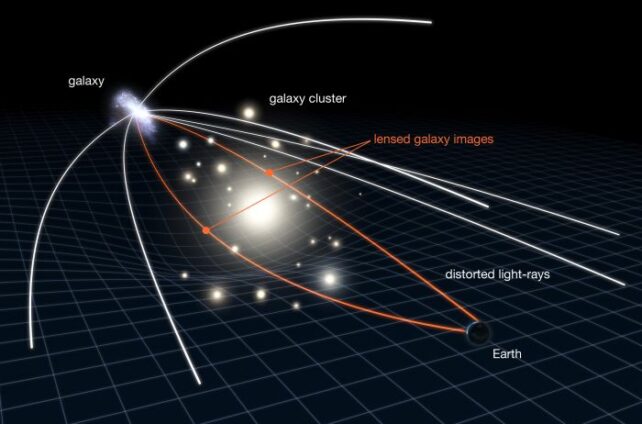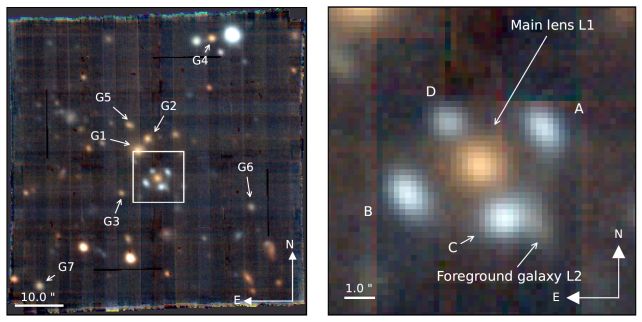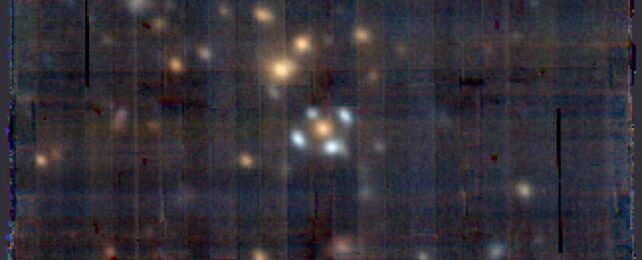A massive galaxy has created a rare distortion in the path of light that has traveled billions of years to reach us from a more distant galaxy.
It's called an Einstein cross – when the curvature of space-time around a massive foreground object splits the light behind it into four, like the points of a cross. Its confirmation and analysis adds to a slowly growing catalog of these rare alignments, which can help us better understand the more distant reaches of the Universe.
A paper detailing the system has been accepted by The Astrophysical Journal Letters, and is available on preprint resource arXiv.
Space-time isn't nice and flat. Gravity causes it to warp and wrinkle, which can have some interesting effects on any light traveling through it. Mostly, we observe these as something we call a gravitational lens.
Imagine, for example, a trampoline. If you place a heavy weight on the trampoline, the mat stretches and becomes curved. Anything then rolling across the mat follows the stretched and curved shape. Something similar happens to space-time: if a mass is significant enough, space-time warps and curves around it.
Any light moving through this space-time therefore follows a curved path, and comes out looking quite different on the other end. The foreground mass creates a warping and magnifying effect, like a large… well, lens.

How this background light emerges varies; sometimes it's smeared, sometimes it's mirrored, sometimes it's a ring. But if the alignment is just right, what you get are four duplications arrayed around the foreground object. That's the Einstein Cross, and they're both rare and beautiful.
Led by astronomer Aleksandar Cikota of NSF's NOIRLab, an international team of scientists has confirmed a particularly gorgeous example in Dark Energy Spectroscopic Instrument (DESI) Legacy Imaging Surveys data.
The gravitational lens was first discovered in 2021, but Cikota and his colleagues have conducted follow-up observations using the Very Large Telescope's MUSE instrument that confirm its classification as an Einstein cross.
Their image shows a massive red foreground galaxy. Around it, four blue lights are arrayed; these are duplicated images of a more distant lensed galaxy. Together, the system has been named DESI-253.2534+26.8843.

The researchers also conducted modeling using software called GIGA-Lens, a framework for modeling strong gravitational lenses. This allowed them to quickly and accurately calculate the properties of the system, finding that the total magnification of the source galaxy is 10.47.
They were also able to probe the effects of a smaller foreground galaxy that has a weaker lensing effect.
This information is important for probing the properties of lensed galaxies in the distant Universe. The magnification allows us to see them in greater detail, but you need a firm understanding of the precise effect the lens has on the light that travels through it. The team's work shows us that, using modeling, we can derive the properties of a gravitational lens faster than we could previously.
"We have achieved greater than two orders of magnitude speedup," they write in their paper.
"This concretely demonstrates a very promising future of modeling of strong lensing systems that are expected to be discovered in the next decade."
The research has been accepted into The Astrophysical Journal Letters, and is available on arXiv.
